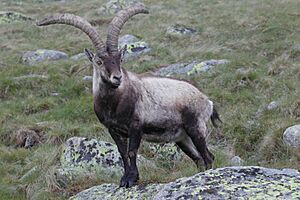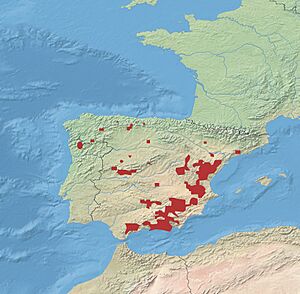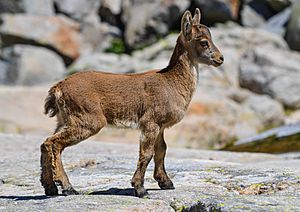Iberian ibex facts for kids
Quick facts for kids Iberian ibex |
|
|---|---|
 |
|
| Male C.p. hispanica | |
 |
|
| Female C.p. hispanica | |
| Conservation status | |
| Scientific classification | |
| Subspecies | |
|
Capra pyrenaica hispanica |
|
 |
|
| Distribution of the Iberian ibex |
The Iberian ibex (Capra pyrenaica), also known as the Spanish ibex or Spanish wild goat, is a type of ibex that lives only in the Iberian Peninsula (Spain and Portugal). There used to be four different kinds, called subspecies, but sadly, two of them are now extinct. The Portuguese ibex disappeared in 1892, and the Pyrenean ibex became extinct in 2000. Scientists even tried to clone the Pyrenean ibex, and one clone was born in 2003, but it only lived for a few minutes. This made it the first animal to be "un-extinct" for a short time!
Contents
Different Types of Iberian Ibex
A subspecies is like a special group within a species. These groups have small differences, often because they live in different areas.
- Southeastern Iberian ibex (or Beceite ibex) – Capra pyrenaica hispanica
- Western Iberian ibex (or Gredos ibex) – C. p. victoriae
- Portuguese ibex – C. p. lusitanica (This one is extinct)
- Pyrenean ibex – C. p. pyrenaica (This one is also extinct)
What Makes the Iberian Ibex Special?
The Iberian ibex has big, flexible hooves and short legs. These special feet help it run and jump easily on rocky, steep mountains. This keeps them safe from animals that might try to hunt them.
Their horns curve out, then up, then back, and then inward. Depending on the subspecies, they might curve up or down again. The horns grow more each year, especially as the ibex gets older.
Male and female ibex look different. This is called sexual dimorphism. Males are bigger and heavier than females. They also have much larger horns. Female ibex bones finish growing almost two years before male ibex bones.
Where Do Iberian Ibex Live?
The Iberian ibex lives in the Iberian Peninsula, which includes Spain and Portugal. Originally, there were four subspecies. But because two of them became extinct, only two types still exist today.
You can find these ibex in Spain and northern Portugal. There's also a small group that was brought back to the French Pyrenees mountains. They used to live in Gibraltar and possibly Andorra, but they are no longer found there.
How Iberian Ibex Live and Eat
What Do Iberian Ibex Eat?
Iberian ibex eat a mix of plants. They can be both browsers (eating leaves and twigs) and grazers (eating grass). What they eat depends on what plants are available where they live. This changes with the altitude, location, and season.
Ibex have a special way to store fat in their kidneys. This fat gives them energy during cold winter months when food is scarce. They have the most fat stored during warm seasons when there's plenty of food.
Their eating habits also change with the seasons. In winter, when food is hard to find, ibex move less while looking for food. But in spring, when food is more plentiful, they move around more. This helps them find enough to eat, even with more competition from other animals.
Reproduction and Life Cycle
Iberian ibex form two main types of social groups. There are groups made up only of males, and groups of females with their young.
During the mating season, which is usually in November and December, males join the female groups to reproduce. Young ibex, called yearlings, are separated from the female groups when new babies are born. The young males are the first to leave and go back to the male-only groups. The young females eventually return to their mothers and stay with the female group for a few more years.
Protecting the Iberian Ibex
The number of Iberian ibex has gone down a lot over the last few centuries. This is likely due to several reasons. These include too much hunting, farms taking over their land, and their natural homes getting worse.
Around 1890, one subspecies, the Portuguese ibex, disappeared from Portugal and Galicia. By the mid-1800s, another subspecies, the Pyrenean ibex, had lost most of its living area. It finally became extinct in January 2000, when the last female died in the Ordesa National Park.
Today, there are still threats to the Iberian ibex. These include too many ibex in one area, diseases, and competition with farm animals and other wild animals. Human activities like tourism and hunting can also disturb them.
Recently, ibex in southern Spain have faced outbreaks of a disease called sarcoptic mange. This is like scabies in humans. This disease can be deadly for infected ibex. It affects males and females differently and can make it harder for them to reproduce. Sarcoptic mange has become a major problem for many Iberian ibex populations.
Images for kids




